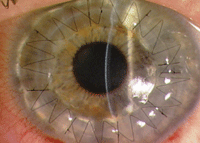
|
I have a patient who must undergo a full-thickness corneal transplant for advanced keratoconus. He asked about any risk or concern for transmitted disease, including prion disease. What precautions do eye banks take to assure there's no transmission with prion disease or other diseases that could be transmitted through transplantation (HIV, hepatitis B, etc.)?
“Eye banks have strict standards for evaluating the safety of donor corneas, so the risk for transmitted disease is extremely low,” says Penny Asbell, MD, professor of ophthalmology and director of the Cornea Service at Mount Sinai School of Medicine in New York.
In more than 50 years of eye banking—and over 1 million successful transplantations—corneas have transmitted only three different types of viruses: those responsible for Creutzfeldt-Jakob disease (three cases), hepatitis B (two cases) and rabies (one case).1,2
Of the three cases reported of Creutzfeldt-Jakob disease (CJD)—a prion disease—transmitted by corneal transplantation, only one was confirmed by histopathologic examination of both subject and donor, says An Vo, MD, who also practices at Mount Sinai.
The medical standards of the Eye Bank Association of America (EBAA) exclude all donors with known CJD as well as anyone with a family history of a blood relative with CJD.
“Since the imposition of medical standards in 1980, there have been no cases of CJD detected in the United States donor pool,” Dr. Asbell says.2

|
|
|
Can a donor cornea transmit prion disease, such as Creutzfeldt-Jakob, to the recipient? Before eye bank standards were revised, it was rare. Now, it's nearly impossible.
|
EBAA’s medical standards also exclude those who have had human pituitary-derived growth hormone, cases of death of unknown cause, and cases of death with neurologic disease where the diagnosis is not established.
Meanwhile, in 1993, the Food and Drug Administration established the Interim Rule for Human Tissue Intended for Transplantation. This regulation requires screening of corneal donors and serologic testing for HIV and hepatitis B and C. This rule duplicated several EBAA medical standards, which had already been in effect for several years, to screen and test for these three agents.
“In addition, because syphilis screening is required for organ and other tissue donors, many eye banks still test for syphilis as part of donor evaluation, although no cases of syphilis transmitted through corneal transplantation have ever been reported,” Dr. Vo says.
1. Chu W. The past 25 years in eye banking. Cornea. 2000 Sep;19(5):754-65.
2. Hogan RN, Heck E, Cavanagh HD. Risk of prion disease transmission from ocular donor tissue transplantation. Cornea. 1999 Jan;18(1):2-11.

